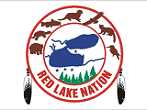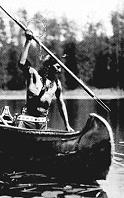 North American Indian cultures
North American Indian cultures
 American Indian artwork
American Indian artworkNorth American Indian languages
 North American Indian cultures
North American Indian cultures
 American Indian artwork
American Indian artwork

 Chippewa Indian Fact Sheet (Ojibwe, Ojibway)
Chippewa Indian Fact Sheet (Ojibwe, Ojibway)This website was written for young people seeking Chippewa Indian information for school or home-schooling reports. We encourage students and teachers to visit our main Ojibwa language and culture pages for in-depth information about the Ojibway/Chippewa tribe, but here are our answers to common questions asked by kids, with Ojibway pictures and links suitable for all ages. Photographs are the property of the sources we have credited.



 Chippewa Tribe
Chippewa Tribe




 What is the difference between Chippewa, Ojibway, Ojibwe, and Ojibwa?
What is the difference between Chippewa, Ojibway, Ojibwe, and Ojibwa? What does "Ojibwe" mean? How do you pronounce it?
What does "Ojibwe" mean? How do you pronounce it? Where do the Chippewas live?
Where do the Chippewas live? land in the northern United States (especially
Minnesota,
Wisconsin and
Michigan) and southern Canada
(especially Ontario,
Manitoba.
and Saskatchewan.)
Here is a map
showing the location of Chippewa and Potawatomi communities in the US and Canada.
land in the northern United States (especially
Minnesota,
Wisconsin and
Michigan) and southern Canada
(especially Ontario,
Manitoba.
and Saskatchewan.)
Here is a map
showing the location of Chippewa and Potawatomi communities in the US and Canada.
 How is the Ojibway Indian nation organized?
How is the Ojibway Indian nation organized?  Flags of Chippewa bands |
Each Ojibwe community lives on its own reservation (or reserve, in Canada).
Reservations are lands that belong to the Ojibwes and are under their control.
Communities of Ojibwe Indians are called tribes in the United States and First Nations in Canada.
Each Ojibwe tribe is politically independent and has its own government, laws, police, and services, just like a small country.
Some Ojibwe nations have also formed coalitions to address common problems.
The political leader of an Ojibway band is called a chief (gimaa or ogimaa in the Ojibway language.) In the past Ojibway chiefs were men chosen by tribal councilmembers, often from among the last chief's sons, nephews, or sons-in-law. Today Ojibway chiefs can be men or women, and they are elected in most Ojibway bands, like mayors and governors. |
 What language do the Ojibways speak?
What language do the Ojibways speak? What was Ojibway culture like in the past? What is it like now?
What was Ojibway culture like in the past? What is it like now? page you can learn about Ojibwe history and view photographs from the Ojibwe Museum.
page you can learn about Ojibwe history and view photographs from the Ojibwe Museum.
 How do Ojibway Indian children live, and what did they do in the past?
How do Ojibway Indian children live, and what did they do in the past? Ojibway string game |
They do the same things any children do--play wi th each other, go to school and help around the house.
Many Ojibway children like to go hunting and fishing with their fathers. In the past, Indian kids had more
chores and less time to play, just like colonial children. But Ojibway kids did have dolls and toys to play with,
and older boys liked to play lacrosse.
Like many Native Americans, Ojibway mothers traditionally carried their babies in
cradleboards on their backs. Here are some pictures of Native American cradle boards. th each other, go to school and help around the house.
Many Ojibway children like to go hunting and fishing with their fathers. In the past, Indian kids had more
chores and less time to play, just like colonial children. But Ojibway kids did have dolls and toys to play with,
and older boys liked to play lacrosse.
Like many Native Americans, Ojibway mothers traditionally carried their babies in
cradleboards on their backs. Here are some pictures of Native American cradle boards.
|
 What were Ojibway men and women's roles?
What were Ojibway men and women's roles? What were Ojibway homes like in the past?
What were Ojibway homes like in the past? Ojibway birchbark house | There were two types of dwellings used by the Chippewas. In the woodlands, Ojibway people lived in villages of birchbark houses called waginogans, or wigwams. On the Great Plains, the Ojibwas lived in large buffalo-hide tents called tipis. The Plains Ojibwa were nomadic people, and tipis (or tepees) were easier to move from place to place than a waginogan. Here are some pictures of wigwam, tipi, and other Indian houses. Today, Native Americans only build a wigwam or tepee for fun or to connect with their heritage, not as shelter. Most Ojibways live in modern houses and apartment buildings, just like you. |
 What was Ojibway clothing like? Did they wear feather headdresses and face paint?
What was Ojibway clothing like? Did they wear feather headdresses and face paint? Chippewa chief  Ojibwa moccasin |
Chippewa women wore long dresses with removable sleeves. Chippewa men wore
breechcloths and leggings.
Everybody wore moccasins
on their feet and cloaks or ponchos in bad weather. Later, the Chippewas adapted European costume such as cloth blouses and jackets, decorating
them with fancy beadwork.
Here are more
pictures of Ojibway clothing styles, and some photographs and links
about Native American clothes in general.
Traditionally, the Chippewas wore leather headbands with feathers standing straight up in the back. In times of war, some Chippewa men shaved their heads in the Mohawk style, with a single strip of hair standing up high in the middle of the man's head. Otherwise, Chippewa men and women both wore their hair in long braids. A Chippewa warrior mi  ght wear a
porcupine roach, which you can still see today at pow-wows.
In the 1800's, some Chippewa chiefs began wearing long headdresses like their neighbors the
Dakota Sioux.
Here are some pictures of these different styles of Native American headdress.
The Chippewas painted their faces and arms with bright colors
for special occasions. They used different patterns for war paint and festive decoration. Some Chippewas, especially men, also wore
tribal tattoos. ght wear a
porcupine roach, which you can still see today at pow-wows.
In the 1800's, some Chippewa chiefs began wearing long headdresses like their neighbors the
Dakota Sioux.
Here are some pictures of these different styles of Native American headdress.
The Chippewas painted their faces and arms with bright colors
for special occasions. They used different patterns for war paint and festive decoration. Some Chippewas, especially men, also wore
tribal tattoos.
Today, some Chippewa people still wear moccasins or a beaded shirt, but they wear modern clothes like jeans instead of breechcloths... and they only wear feathers or roaches in their hair on special occasions like a dance. |
 What was Ojibway transportation like in the days before cars? Did they paddle canoes?
What was Ojibway transportation like in the days before cars? Did they paddle canoes? Ojibway birchbark canoe |
Yes--the Ojibway Indian tribe was well-known for their birchbark canoes.
Canoeing is still popular in the Ojibway nation today, though few people handcraft their own canoe from
birch bark anymore.
Here is a website of birchbark canoe pictures.
Over land, Chippewa people used dogs as pack animals. (There were no horses in North America
until colonists brought them over from Europe.) The Chippewas used
sleds and snowshoes to help them travel in the winter.
Today, of course, the Chippewas also use cars... and non-native people also use canoes. |
  Chippewa woman Chippewa man harvesting rice spear-fishing |
 What was Ojibway food like in the days before supermarkets? What was Ojibway food like in the days before supermarkets?Ojibway bands lived in different environments, so they didn't all eat the same types of foods. Woodland Chippewas were mostly farming people, harvesting wild rice and corn, fishing, hunting small game, and gathering nuts and fruit. Here is a website about Ojibwe wild rice. The Plains Ojibwa were big-game hunters, and bison meat made up most of their diet. Here is a website with more information about traditional Native American food.  What were Ojibway weapons and tools like in the past? What were Ojibway weapons and tools like in the past?Ojibway warriors used bows and arrows, clubs, flails, and hide shields. Hunters also used snares to catch birds, and when Plains Ojibway men hunted buffalo, they often set controlled fires to herd the animals into traps or over falls. Here is a website with pictures and more information about Native American weapons. Woodland Chippewas used spears or fishhooks with sinew lines for fishing, and special paddles called knockers for ricing. |
 What are Ojibway arts and crafts like?
What are Ojibway arts and crafts like? Ojibway beadwork | Ojibway artists are known for their beautiful bead embroidery, particularly floral design. Other traditional Ojibway crafts include Native American baskets and birch bark boxes. Like other eastern American Indians, the Ojibways also crafted wampum out of white and purple shell beads. Wampum beads were traded as a kind of currency, but they were more culturally important as an art material. The symbols and designs on wampum belts often told a story or represented a person's family. |
 Is there an Ojibwe art project I can do for school?
Is there an Ojibwe art project I can do for school? catchers were made out of bent twigs
and some sinew thread, but you could make one out of any round frame and string. Here are some good
online instructions about how to make a
dream
catchers were made out of bent twigs
and some sinew thread, but you could make one out of any round frame and string. Here are some good
online instructions about how to make a
dream catcher.
catcher.
 What is Ojibwe music like?
What is Ojibwe music like? What other Native Americans did the Chippewa tribe interact with?
What other Native Americans did the Chippewa tribe interact with? What kinds of stories do the Chippewas tell?
What kinds of stories do the Chippewas tell? What about Chippewa religion?
What about Chippewa religion? Can you recommend a good book for me to read?
Can you recommend a good book for me to read? How do I cite your website in my bibliography?
How do I cite your website in my bibliography?
 Ojibway Indian Tribe
Ojibway Indian Tribe
 Ojibwe Language Resources
Ojibwe Language Resources
 Ojibwe Culture and History Directory
Ojibwe Culture and History Directory
 st and present.
st and present.
 Ojibwe Words
Ojibwe Words

Return to American Indians for Children
Return to our menu of Indian tribes of North America
Check out our evolving medicine wheel logo

Native American jewelry
 Blackfeet
Blackfeet
 Copper River
Copper River
 Apache county
Apache county
 American Indian translations
American Indian translations
Would you like to help support our organization's work with the Chippewa language?
 Contact us
Contact us  Follow our blog
Follow our blog